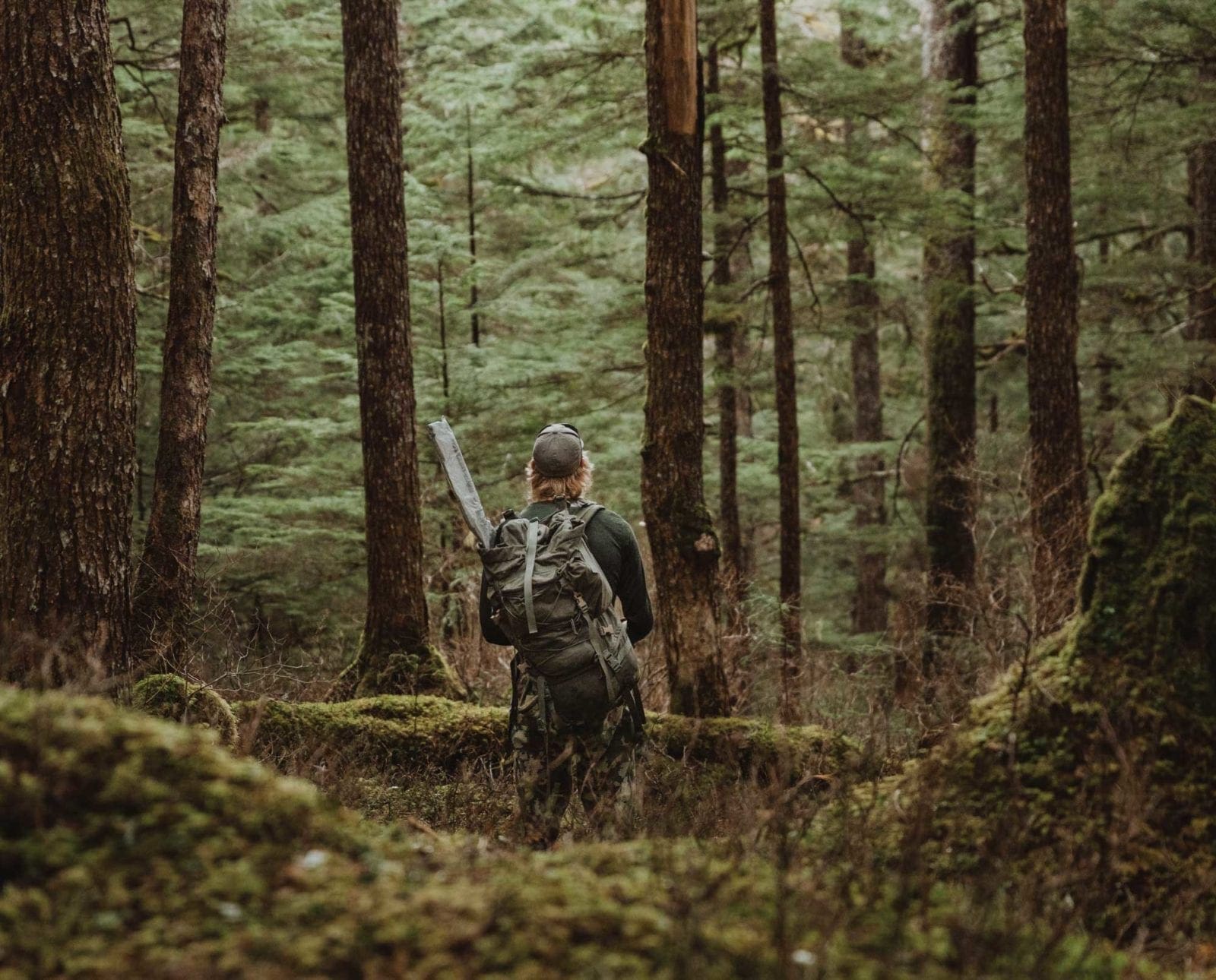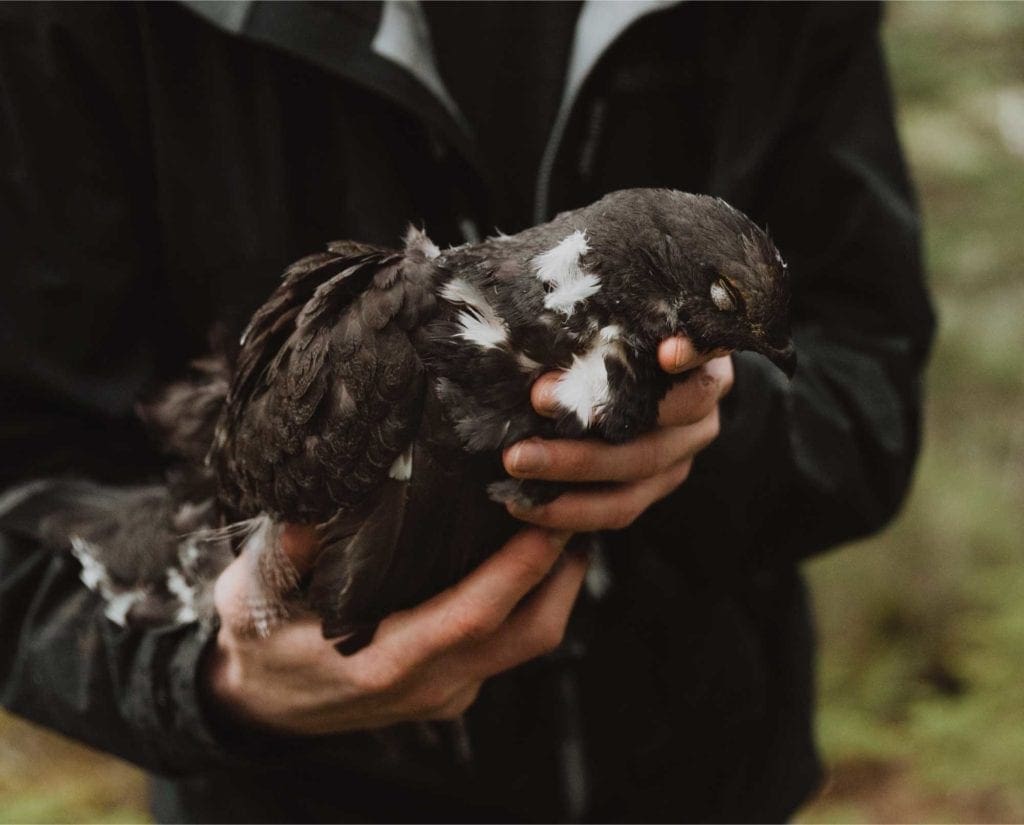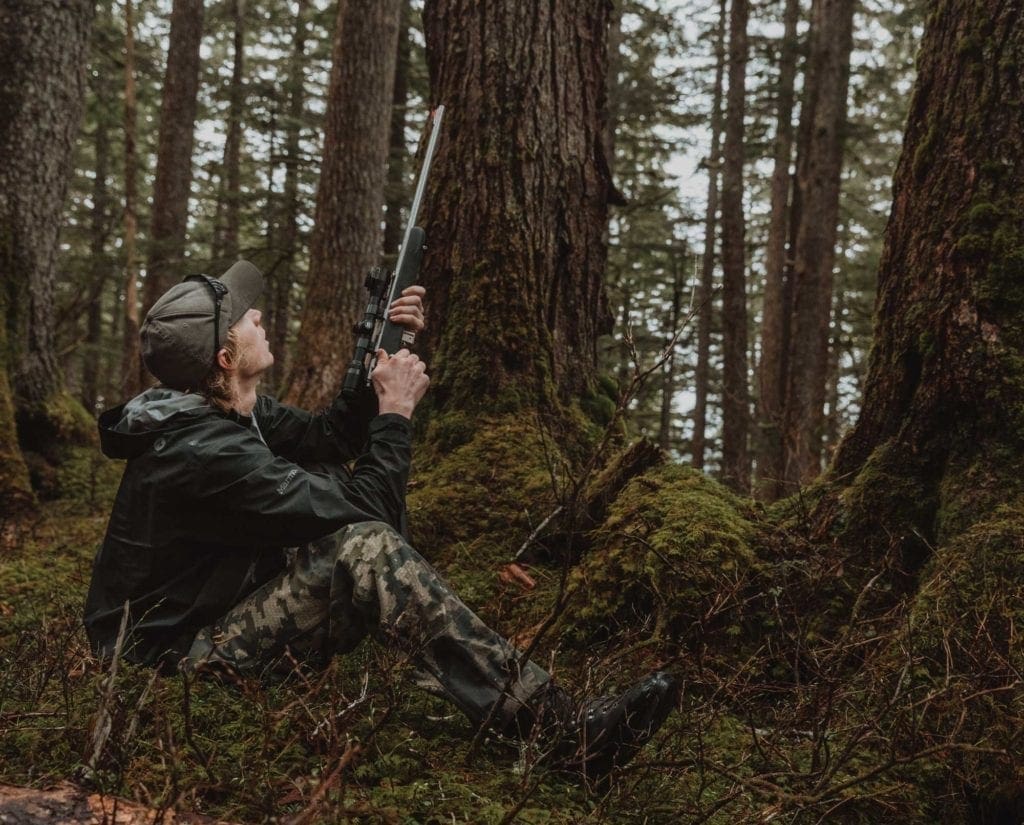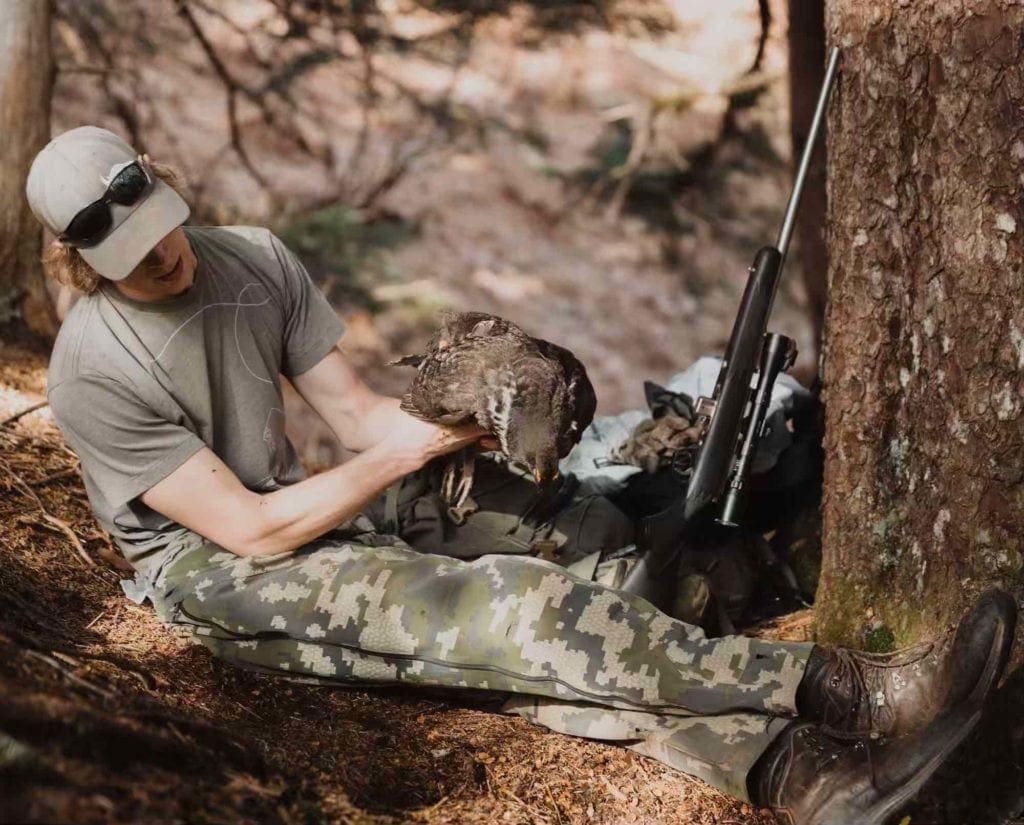Home » Grouse Species » Blue Grouse Hunting » How to Hunt Sooty Grouse During the Spring Hoot
How to Hunt Sooty Grouse During the Spring Hoot

Casey McConnell was born and raised in Alaska and has…
Hunting sooty grouse in the spring months in Alaska is an unusual adventure with plenty of unique considerations
Imagine the typical grouse hunting scene: the fall air is crisp and the leaves of a deciduous forest crunch underfoot as you stalk the wooded edge of a field while anticipating a point or a flush from the bird dog that works in front of you. Maybe there’s a bird in your vest already and you’re hoping for another, not knowing what lies beyond the next step.
Springtime sooty grouse hunting in southeast Alaska is nothing like that. It goes against the grain of traditional grouse hunting in nearly every way. It takes place in the spring months, there may be no deciduous trees for miles, and “fields” only occur below the tideline or above the timberline. Shotguns are usually left at home and the only thing at the ready is either bear spray or a .44 magnum. Both hands are needed for climbing or to gingerly hold devil’s club away from your tender bits. Vests are replaced with backpacks. Hunting with a dog does not increase your success rate. If the woods are silent, then there are no grouse close by, or at least none that you will find. Its very weirdness is what makes this hunt amazing.
Spring in many parts of southeast Alaska is announced by the mating calls of male sooty grouse—they’re perched in the boughs of hemlock or spruce, making a sound akin to blowing across the top of a glass bottle. This hollow “whooooop” almost sounds like its own echo and may carry for a mile. Hooting might start in late March, but it will generally be more widespread and consistent after the first week of April. The “hoot” can last well into June, though the spring hunting season ends in mid-May.
SUBSCRIBE to the AUDIO VERSION for FREE : Google | Apple | Spotify
Where to hunt for sooty grouse in the spring
Despite their distribution as far south as California, the only state that presently allows sooty grouse hunting in the spring is Alaska. Their distribution within Alaska overlaps the Tongass National Forest from Ketchikan in the south to somewhere around Lituya Bay. While they can and do inhabit many of the islands in the Alexander Archipelago, it seems that the highest densities are closer to the mainland, perhaps due to the slightly drier climate created by the islands’ buffering of the maritime humidity coming from the Gulf of Alaska.
When exploring new-to-me areas to hunt sooty grouse, I focus my attention on slopes that face south or at least receive a good amount of direct sun throughout the day. The birds do inhabit north-facing slopes, but the vast majority of the grouse I’ve found have been on more southerly aspects. Locating a sooty grouse from afar is not difficult as long as you can hear the hoot. If you can’t hear them, keep hiking! If the weather is nice and bald eagles or hawks do not disturb them, males will generally hoot from sun-up to sun-down. Of course, pinpointing their exact location once you hear the hoot is another matter entirely.
Be prepared for a tough hike. You can forget about following a maintained trail directly to a bird—there’s a lot of bushwhacking involved. Usually, sooty grouse can be found hooting from 500-1,800 feet above sea level.

Locating the sooty grouse from the hoot
Sooty grouse blend in very well with the boughs of the treetops. The dark timber with dappled back-lighting makes spotting them tough. Making things even more difficult is the fact that sooty grouse are rarely moving around in the tree—the head and tail will bob as they hoot, but even that is subtle. Add a gentle breeze moving some boughs and you’re in for a tough spot.
Occasionally a hoot will be loud and booming—if you’re close you can sometimes feel it in your chest—and the next hoot will be faint and quiet and sound like it is several trees away. Don’t be fooled! It is not two grouse hooting at each other, but instead one single bird hooting in different directions and the hoot is echoing off a nearby tree. This is why they’ve often been compared to ventriloquists.
One effective tactic to pinpoint their tree is to circle the tree or clump of trees and triangulate the position of the bird. Gaining elevation on the suspected tree is a huge advantage. It is much easier to see into the tree horizontally rather than looking up through branches with diameters that might be as large as or larger than the bird.
Sometimes I’ve searched for a bird for an hour, while other times I’ll spot them immediately. If you don’t see it, keep moving and keep looking. Don’t give up unless it stops hooting; once they go quiet, they can become almost impossible to spot. If a grouse does stop hooting it may be able to see you and be nervous. They will rarely fly away when nervous, so just move away, take lunch, air out your boots, and wait a while. I generally only wait fifteen minutes or so, less if I know that I’ll come back this direction later in the day—he’ll still be there.
Special considerations for spring grouse hunting
Remember the slope and aspect I mentioned? Hunting on flat land is difficult because spotting them is tougher and the hoot does not carry as far. I don’t bother hiking around on plateaus or on the flats unless it’s to get to another hillside. Also, more light penetrates the canopy of a forest growing on flat ground, allowing the understory to flourish, which makes hiking a real challenge.
Since this hunt takes place during the time where hibernating bears are emerging from their dens, being bear-aware is important and being able to see more than a few feet in all directions makes me much more comfortable. Hiking with a partner is safer than solo and I find it more enjoyable. The extra noise of two or three people hiking won’t hurt your chances of success finding a bird (more eyes could actually help), but it might alert a bear of your presence before you spook them at a dangerously close range.
Gear for sooty grouse hunting
In addition to bear protection measures, carrying a satellite messenger might add additional peace of mind, since cell service in southeast Alaska can be sparse. Binoculars come in handy for spotting the more well-hidden birds. One item I never leave home without is leather gloves; the devil’s club in early spring is dry and brittle and thorns break off easily. Pushing them aside as you go can prevent a lot of thorny pokes.
Other gear to have along on the hunt depends on the snow level. Following hoots in April will generally take you above the snow line, so wearing gaiters or bringing snowshoes might be prudent. I’ve brought crampons several times, used them once, and wished I had them on more occasions than my mom would like to hear about.
Finally, there’s usually plenty of flowing water, so I always carry a small bottle and a water filter to use whenever I get thirsty. This saves weight over packing in enough water to drink for the day.

Why use a rifle for hunting sooty grouse
One thing that makes the springtime sooty grouse hunt arguably the best for introducing new hunters to the sport is that one group of hunters can share a firearm since nothing happens quickly. Because the males space themselves out, there’s only one to shoot at a time. They aren’t flying when you take the shot, so because they are usually stationary in the tree, they allow the hunter plenty of time to take a relaxed shot.
I’ve been asked numerous times by bird hunters from outside Alaska that stumble across my social media posts why I shoot them stationary as opposed to a more sporting shot on the wing, or why I don’t use a shotgun. Well, why make things harder than they have to be? The grouse feel safe in their tree and virtually never flush. Even in the rare instance that I’ve surprised one on the ground, he’s just risen to the lowest limb of the nearest tree and looked at me.
I’ve had to shoot at grouse from 60-70 yards since that was the only clear shooting lane, but the next grouse was barely 10 yards away when I spotted it. If you only get a few pieces of shot in a sooty grouse that’s perched far away, they could still dive out of the tree and glide a half mile downhill before dying. The bird would be lost. If you had a short shot using the same load, it would certainly be overkill.
Most people shoot a scoped .22 and aim for the head. Even if you miss the head or neck, sooty grouse usually only duck or jump to the next branch and look around before continuing to hoot. My .22 is lighter than my shotgun anyways and easily fits in my backpack or slung across my back, freeing up my hands for the climb.

Give the spring hoot a try
Alaska Airlines flies from Seattle to Ketchikan, Wrangell, Petersburg, and Juneau daily during the spring hoot. It is feasible to land in Juneau in the morning, rent a car, drive to a trailhead, and be closing in on a hooter in under an hour. However, by the end of the season, it’s light for about 17 hours a day, so there’s no rush. April and May are usually the driest months of the year. Bring rain gear anyways; it is a temperate rainforest, after all. Just be prepared to hike hard, get a bit sweaty, and don’t be discouraged if you can’t spot one right away—no matter how experienced of a hunter you are, there is a learning curve to this oddity of an upland hunt.
Casey McConnell was born and raised in Alaska and has grown up fishing and hunting both small and large game. Currently living in Hoonah, Alaska, his "upland" hunts mainly consist of sooty grouse in the spring and rock ptarmigan in the alpine in the fall. The name of his Small Munsterlander, Keta, pays homage to the species of salmon (O. Keta) that Casey focused on in graduate school. A fitting name since the fish, the dog, and the owner all enjoy splashing around in creeks.



